| Vintage Pulp | Sep 23 2020 |

Recent excavation reveals rare and wonderful treasures.
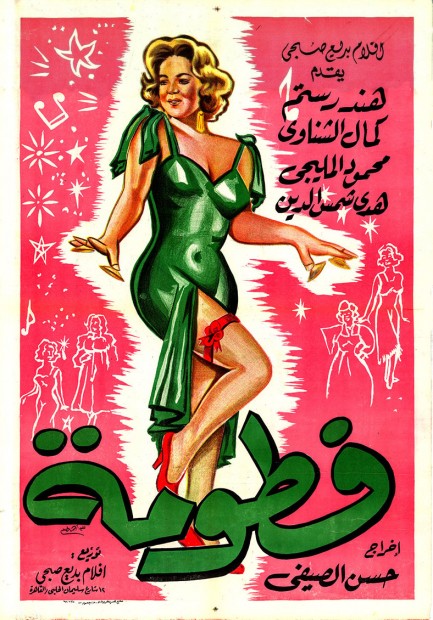

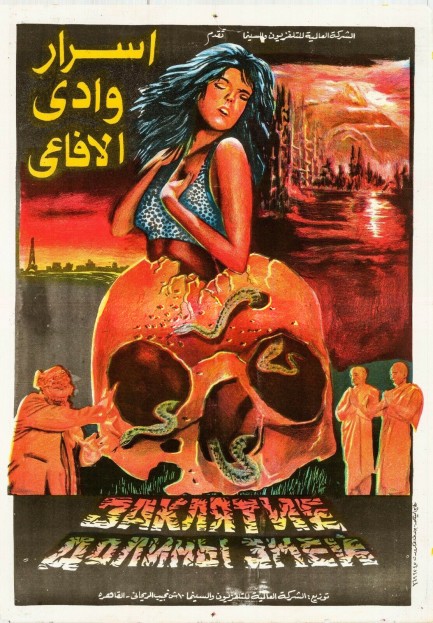
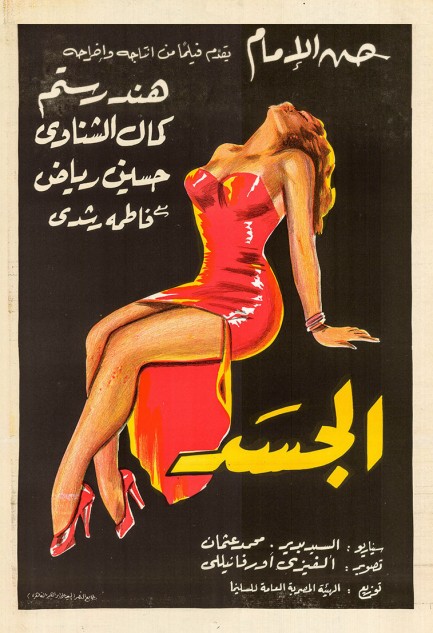
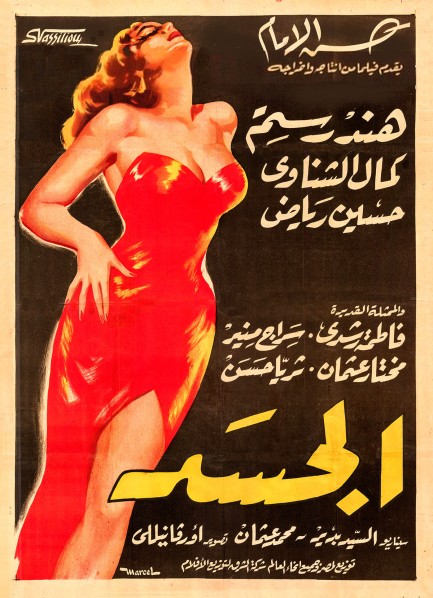
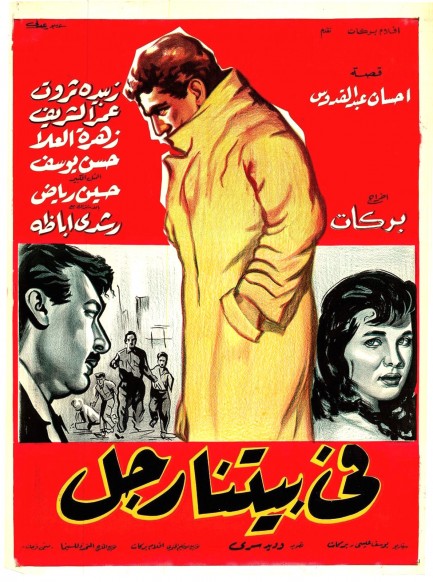

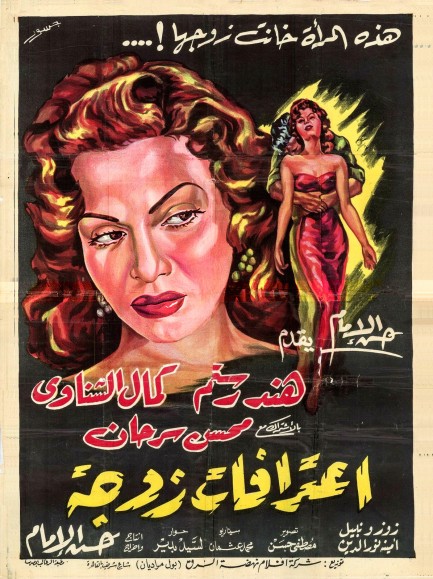
Egypt is a land of ancient artifacts, but it isn't one of pulp or pulp influenced art. Even so, we did some deep digging and found a few items that may fit the bill. These movie posters were painted by artists such as Ahmed Hamed, Hassan Mazhar Gasour, and the tandem of Stamatis Vassiliou & Marcel during the ’50s, ’60s, and ’80s. You see here, top to bottom, Fattouma, 1961, Thawrat el-Madinah, aka A Town's Revolt, 1955, Klatwa doliny wezy, aka Curse of Snakes Valley, 1988, two posters for El gessad, aka Flesh, 1955, two posters for Fi baitina rajul, aka There Is a Man in Our House, 1961, starring Omar Sharif, and finally, Iterafat zauja, aka A Wife's Confession, 1954. These may not be executed as the highest level, but they're quirky and colorful, which is good enough for us. We'd take any of these in a frame and be happy. See another Egyptian poster with Pam Grier—or a reasonable likeness of her—at this link.
| Vintage Pulp | Jun 21 2020 |

If you're going to have a fantasy make it a doozy.
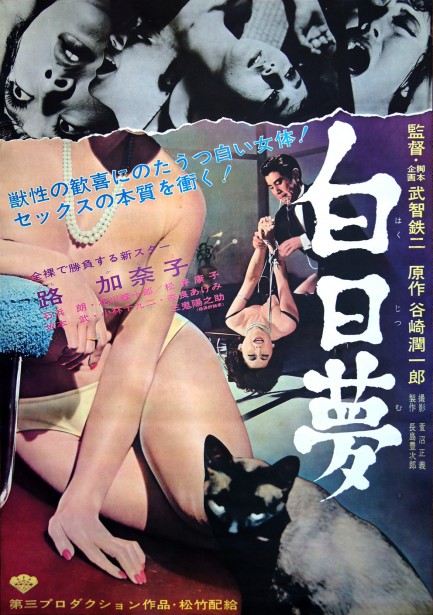

We have two exceptionally beautiful Japanese posters today. These were made for Hakujitsumu, known in English as Daydream. That's an unusually concise Japanese title, but this won't be a concise post. The movie is loosely based on a 1926 novel by Junichir Tanizaki, and was one of the first films classified as pinku eiga, as well as one of the first erotic productions to have a big budget and a run in mainstream cinemas. It also played outside Japan, with a screening at the 1964 Venice Festival and a release in Stateside cinemas. And because of its success, director Tetsuji Takechi remade the film in hardcore style, not once, but twice, in 1981 and 1987, both times starring Kyōko Aizome, who we've talked about before.
The premise of this is fascinating. Akira Ishihama meets Kanako Michi in their dentist's waiting room. Later, as both of them are receiving anesthesia, Ishihama looks over and sees—because apparently Japanese dentistry meant placing two patients into the same room—the dentist and a nurse strip Michi, then seemingly suck her blood like vampires. Was it an anesthetic dream, or a real occurrence? Ishihama needs to uncover the truth. He goes to a nightclub where Michi sings, sees the dentist approach her and demand that she leave with him. Ishihama follows—or actually sort of teleports after them—and later sees Michi submit to various forms of kinky bondage. But is any of what he's seeing real? The title of the film gives that away, doesn't it?
We wonder if Hakujitsumu used the plot device of fantasy because it softened the idea of the bondage and weirdness Michi goes through. Well, all that would soon become routine in Japanese cinema. In addition this was the first Japanese film to show an actress fully naked—which happens for extended periods. Most write-ups say there's even pubic hair shown, but we'll admit we blinked and missed it if that was the case. What we didn't miss was what a clear precursor to the pinku genre of roman porno Hakujitsumu is. Here those elements seem novel; by the 1970s, they wouldn't be, and as a result filmmakers were by then pushing the envelope with violence, water sports, and enemas. That envelope could have stayed flat, as far as we're concerned. Hakujitsumu premiered in Japan today in 1964.
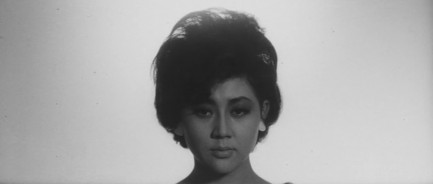

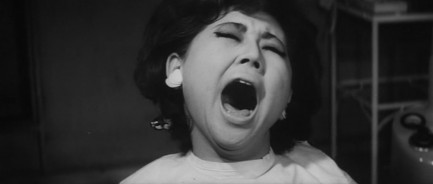
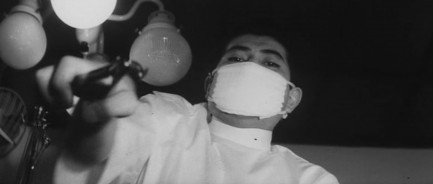
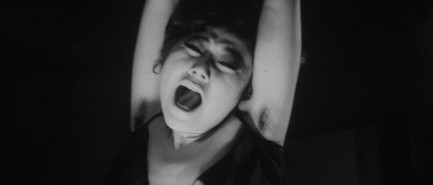
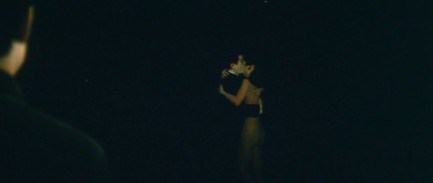
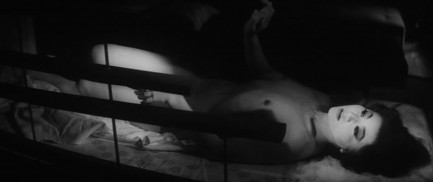

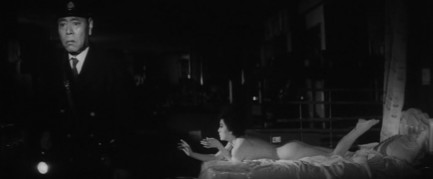
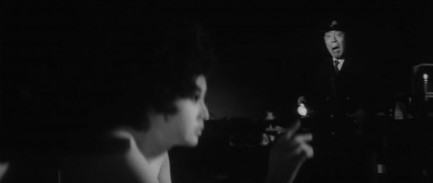
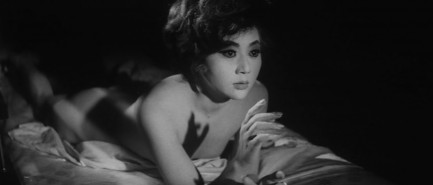
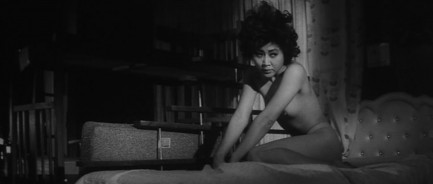
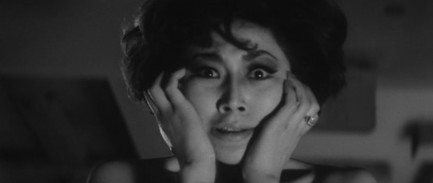
| Intl. Notebook | May 12 2020 |

Hitchcock says no festival for you this year!

The 73rd edition of the Festival de Cannes, aka the Cannes Film Festival, would have kicked off today in the south of France, but was cancelled a while back. It's just one of a wave of event cancellations that will cascade through the year. Festivals as diverse as Burning Man and San Fermin, aka the Running of the Bulls, have also been shelved. But getting back to Cannes, we thought this would be a good moment to commemorate past fests with some historical photos. Above you see Alfred Hitchcock on a boat with the town in the background, in 1972, and below are about fifty pix from the 1940s through 1970s, documenting various iconic moments, and a few quieter ones. Maybe the Cannes Film Festival will back next year, maybe not. At this point, predicting anything is an exercise in futility. But at least we'll always have the memories.
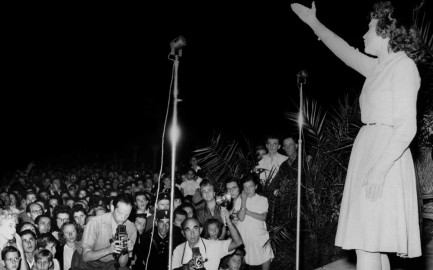
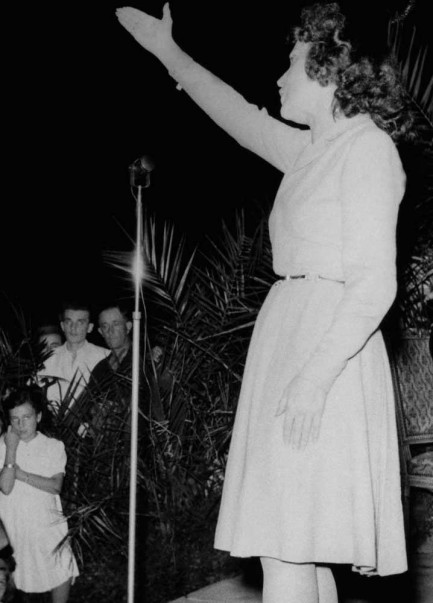 Edith Piaf sings on the terrace of the Carlton Hotel on the iconic Boulevard de la Croisette at the first Festival de Cannes to be held under that name, in 1946. Back then the event took place in September and October, but would shift to May a bit later.
Edith Piaf sings on the terrace of the Carlton Hotel on the iconic Boulevard de la Croisette at the first Festival de Cannes to be held under that name, in 1946. Back then the event took place in September and October, but would shift to May a bit later.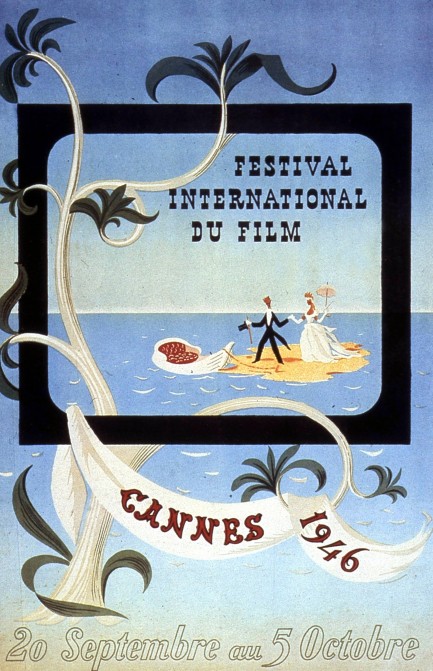
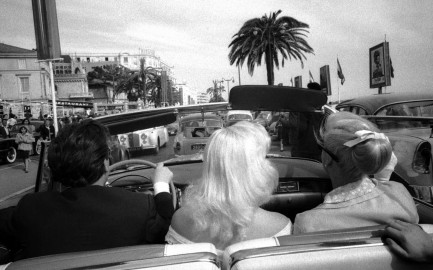 Diana Dors and Ginger Rogers arrive at the fest the only way anyone should—breezing along the beachfront in a convertible, in 1956, with an unknown driver.
Diana Dors and Ginger Rogers arrive at the fest the only way anyone should—breezing along the beachfront in a convertible, in 1956, with an unknown driver.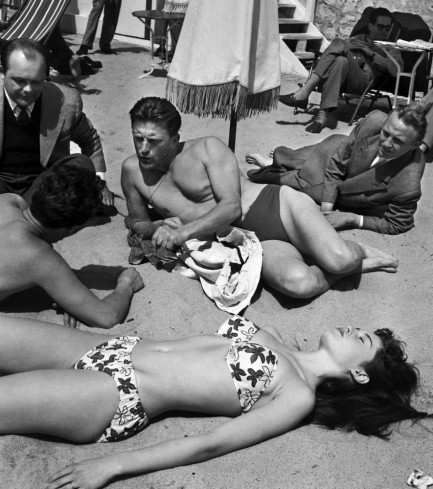 Kirk Douglas holds court on the beach in 1953, and Brigitte Bardot soaks up rays in the foreground.
Kirk Douglas holds court on the beach in 1953, and Brigitte Bardot soaks up rays in the foreground.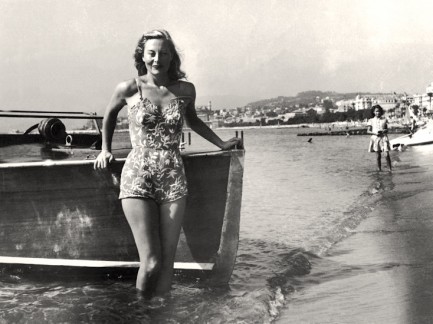 Michele Morgan poses at the first Festival in 1946. Photo ops of this sort were essential sources of publicity for stars, and would soon become opportunities for non-stars seeking to be discovered.
Michele Morgan poses at the first Festival in 1946. Photo ops of this sort were essential sources of publicity for stars, and would soon become opportunities for non-stars seeking to be discovered.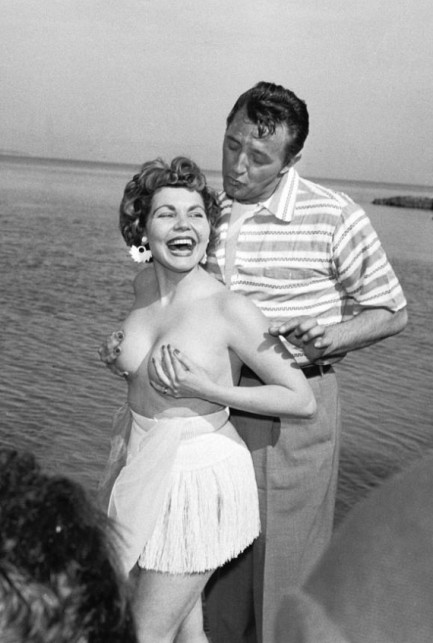 Case in point. Robert Mitchum poses with actress Simone Sylva in 1954. Sylva was allegedly not supposed to be there, but shucked her top and photo-bombed Douglas in an attempt to raise her profile. It didn't work. She made only a couple of credited movie appearances after her topless stunt.
Case in point. Robert Mitchum poses with actress Simone Sylva in 1954. Sylva was allegedly not supposed to be there, but shucked her top and photo-bombed Douglas in an attempt to raise her profile. It didn't work. She made only a couple of credited movie appearances after her topless stunt.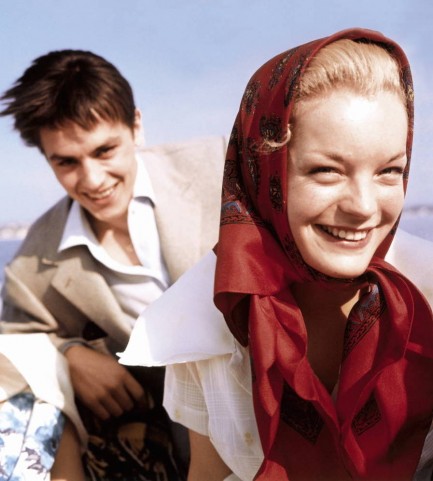 Romy Schneider and Alain Delon at the 1959 fest.
Romy Schneider and Alain Delon at the 1959 fest.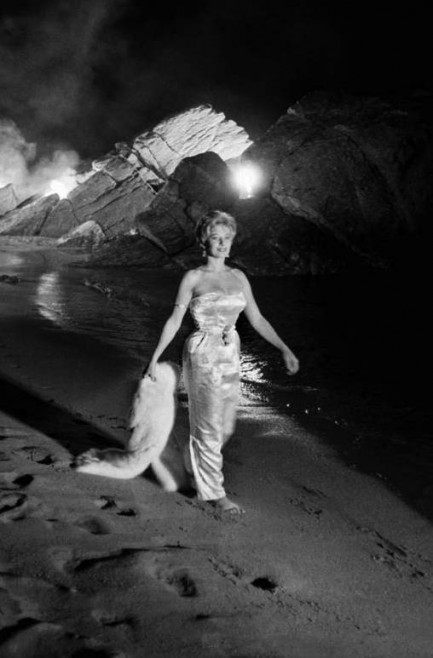 An unidentified model or actress poses in the style of Anita Ekberg from La dolce vita in 1960. This looks like it was shot at Plage du Midi, which is a beach located a little ways west of the Cannes town center.
An unidentified model or actress poses in the style of Anita Ekberg from La dolce vita in 1960. This looks like it was shot at Plage du Midi, which is a beach located a little ways west of the Cannes town center.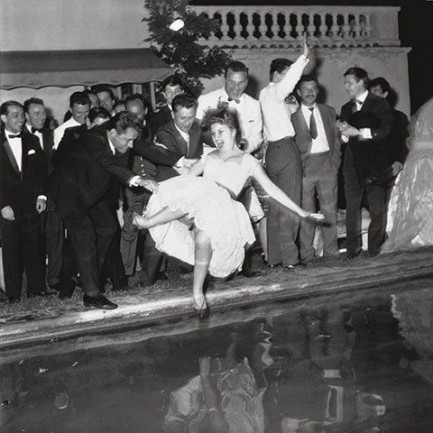 A unidentified partygoer is tossed into a swimming pool after La Dolce Vita won the the 1960 Palme d’Or. The Festival is almost as well known for legendary parties as for legendary film premieres.
A unidentified partygoer is tossed into a swimming pool after La Dolce Vita won the the 1960 Palme d’Or. The Festival is almost as well known for legendary parties as for legendary film premieres.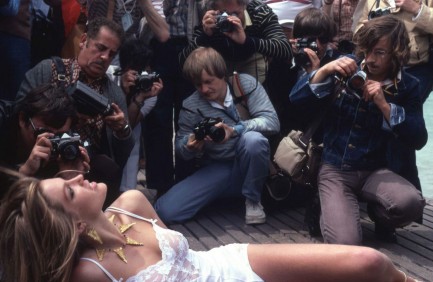
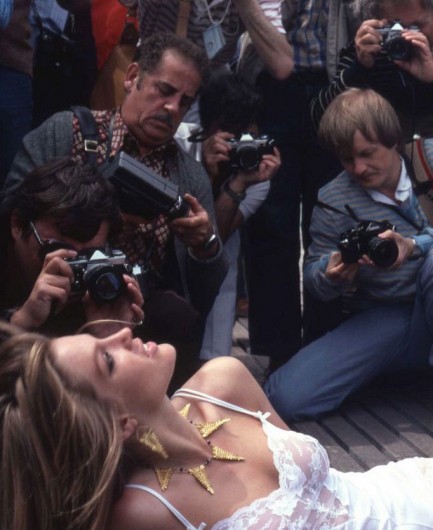 Another unidentified model or actress poses on the boardwalk in 1979. Generally, you don't have to be known to draw a crowd of photographers—you just have to be nearly bare. She's wearing lingerie, so that explains the interest, though this is modest garb for a Cannes publicity stunt. It's never a surprise to see a headline-seeking film hopeful strip all the way down to a string ficelle féminin, or thong, which is the limit of what is legal in Cannes
Another unidentified model or actress poses on the boardwalk in 1979. Generally, you don't have to be known to draw a crowd of photographers—you just have to be nearly bare. She's wearing lingerie, so that explains the interest, though this is modest garb for a Cannes publicity stunt. It's never a surprise to see a headline-seeking film hopeful strip all the way down to a string ficelle féminin, or thong, which is the limit of what is legal in Cannes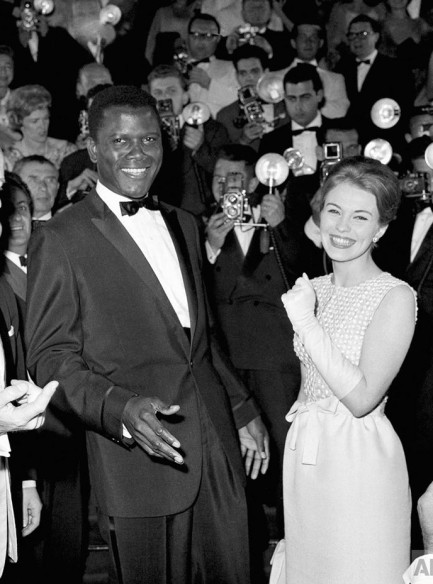 Sidney Poitier and Jean Seberg have a laugh in 1961. This was the year Poitier's flick Paris Blues was released, so it's possible he had jetted down from the capital for the Festival.
Sidney Poitier and Jean Seberg have a laugh in 1961. This was the year Poitier's flick Paris Blues was released, so it's possible he had jetted down from the capital for the Festival.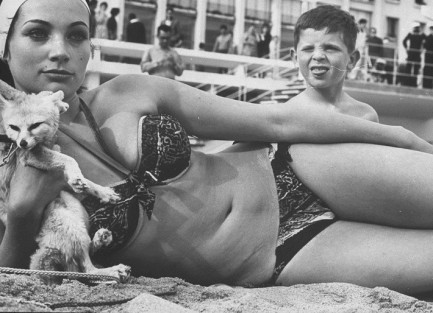 Philomène Toulouse relaxes on the sand in 1962 while a boy practices the classic French look of disgust he'll be using the rest of his life.
Philomène Toulouse relaxes on the sand in 1962 while a boy practices the classic French look of disgust he'll be using the rest of his life. Actor Bernard Blier, 1975.
Actor Bernard Blier, 1975.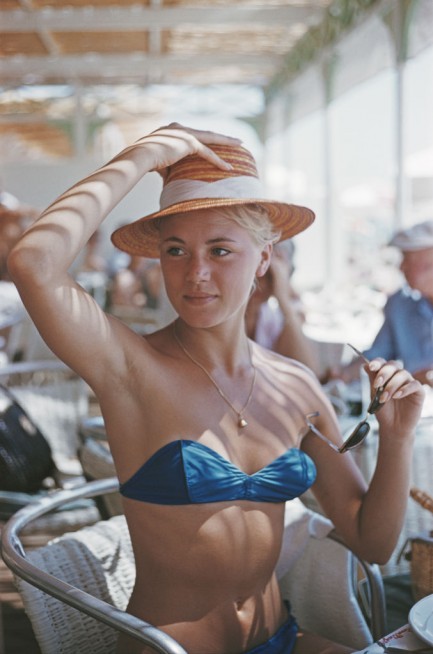 An unidentified bikini wearer boldly enjoys a lunch in a café on the Croisette, 1958.
An unidentified bikini wearer boldly enjoys a lunch in a café on the Croisette, 1958.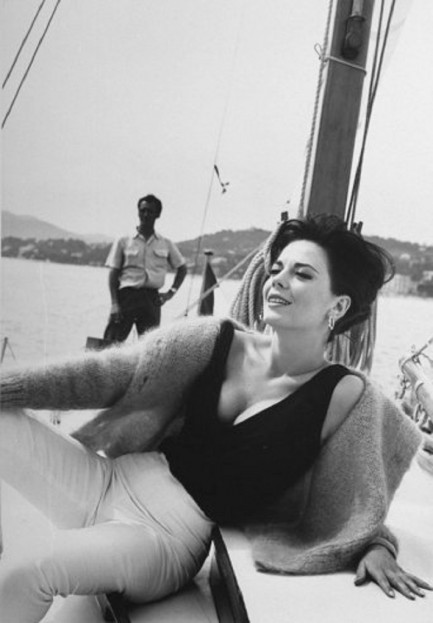 Natalie Wood aboard a sailboat in 1962.
Natalie Wood aboard a sailboat in 1962.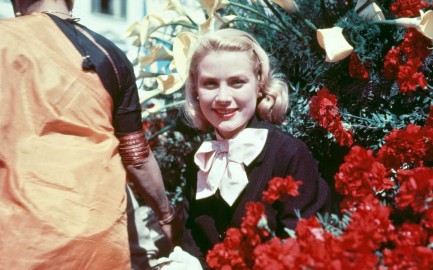
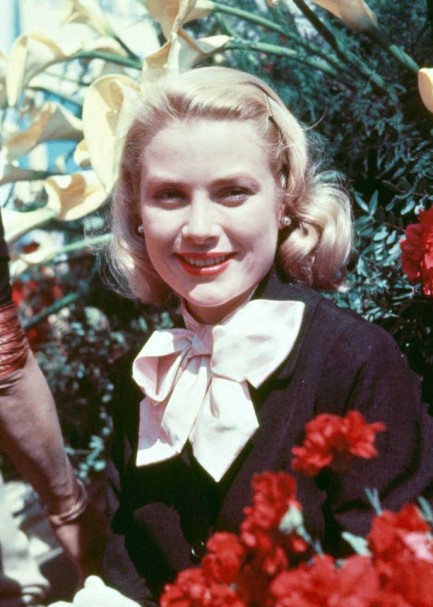 Grace Kelly, 1955.
Grace Kelly, 1955.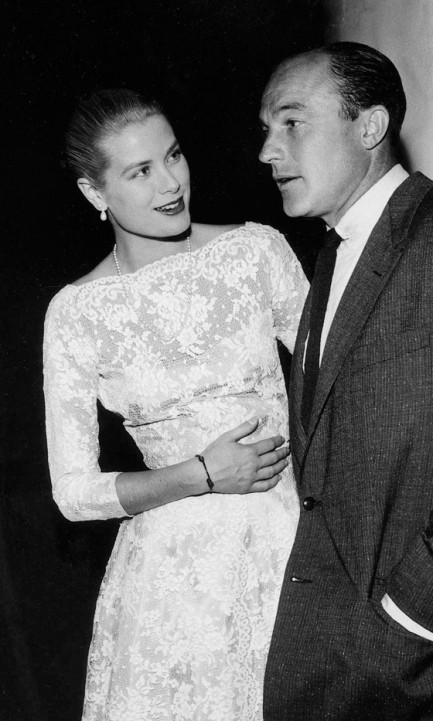 Kelly times two—Grace Kelly and Gene Kelly, hanging out, also in 1955.
Kelly times two—Grace Kelly and Gene Kelly, hanging out, also in 1955.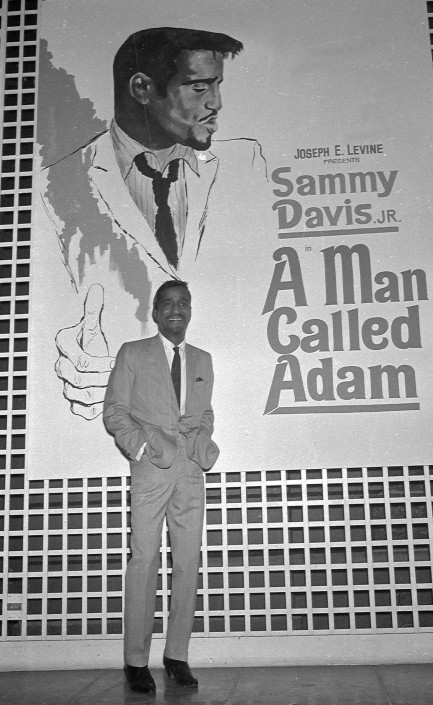 Sammy Davis, Jr. poses in front of a billboard promoting his film A Man Called Adam, 1966.
Sammy Davis, Jr. poses in front of a billboard promoting his film A Man Called Adam, 1966.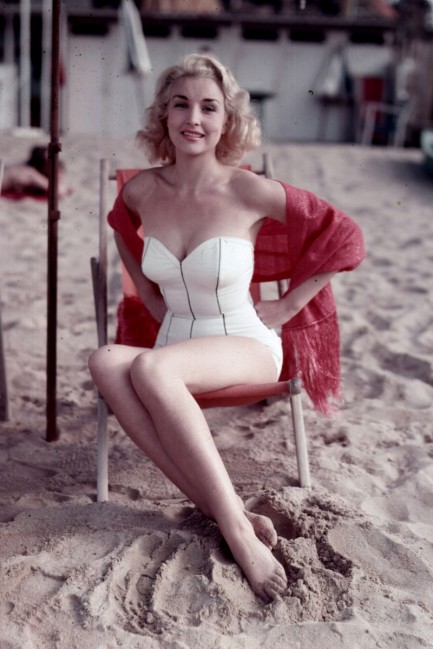 Joan Scott gets sand between her toes in 1955. Scott is obscure. She isn't even the most famous Joan Scott anymore. The IMDB entry for the only Joan Scott near the appropriate age is for an actress born in 1920 who didn't begin acting until 1967. The Joan Scott above doesn't look thirty-five, though, and we doubt she would have been the subject of this somewhat well-known photo without parlaying it into a film appearance before twelve years had passed. So we don't think this is the Joan Scott referenced on IMDB.
Joan Scott gets sand between her toes in 1955. Scott is obscure. She isn't even the most famous Joan Scott anymore. The IMDB entry for the only Joan Scott near the appropriate age is for an actress born in 1920 who didn't begin acting until 1967. The Joan Scott above doesn't look thirty-five, though, and we doubt she would have been the subject of this somewhat well-known photo without parlaying it into a film appearance before twelve years had passed. So we don't think this is the Joan Scott referenced on IMDB.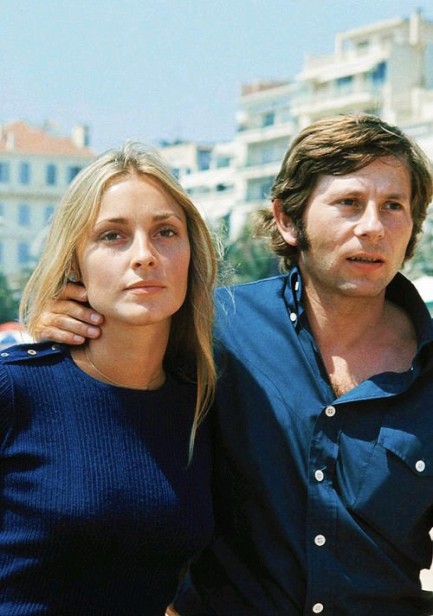
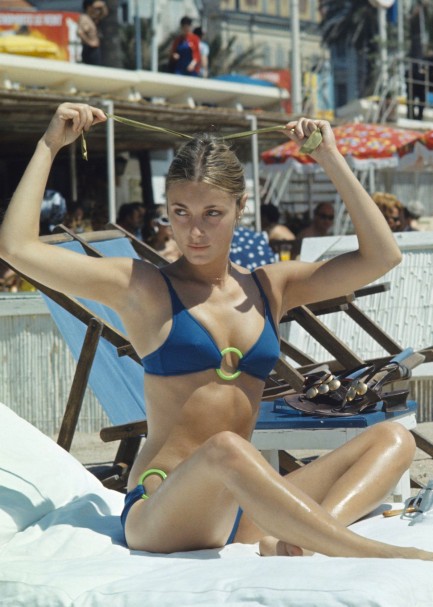 Sharon Tate, with Roman Polanski, and solo, 1968.
Sharon Tate, with Roman Polanski, and solo, 1968.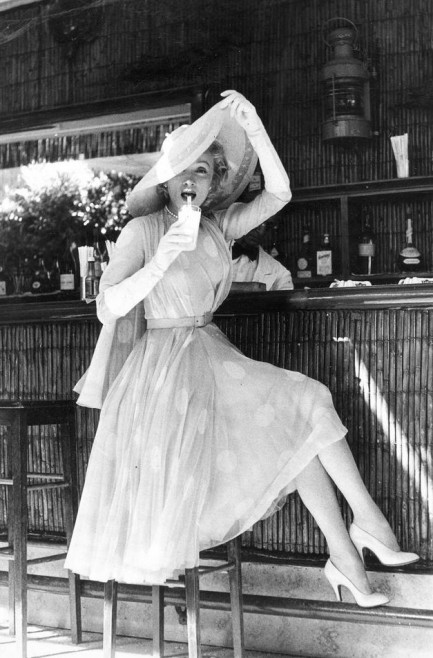 Marlene Dietrich brings glamour to a tiki themed bar in 1958.
Marlene Dietrich brings glamour to a tiki themed bar in 1958.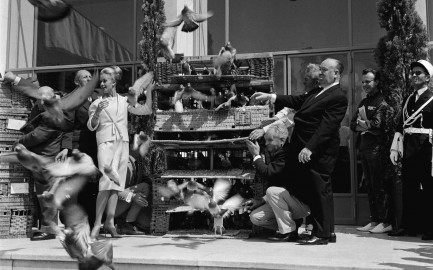
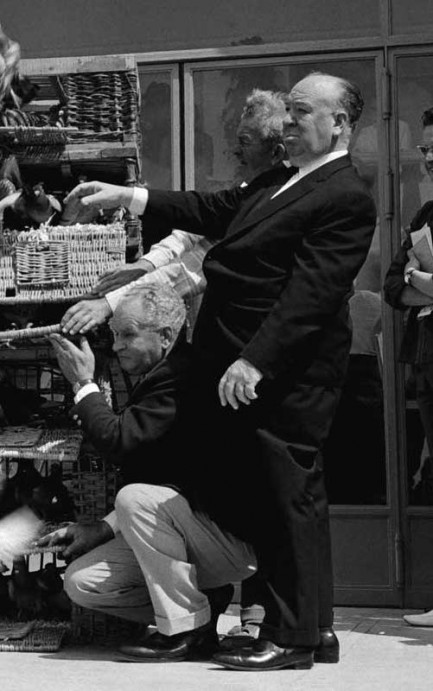 Tippi Hedren and Alfred Hitchcock release caged birds as a promo stunt for The Birds in 1963.
Tippi Hedren and Alfred Hitchcock release caged birds as a promo stunt for The Birds in 1963.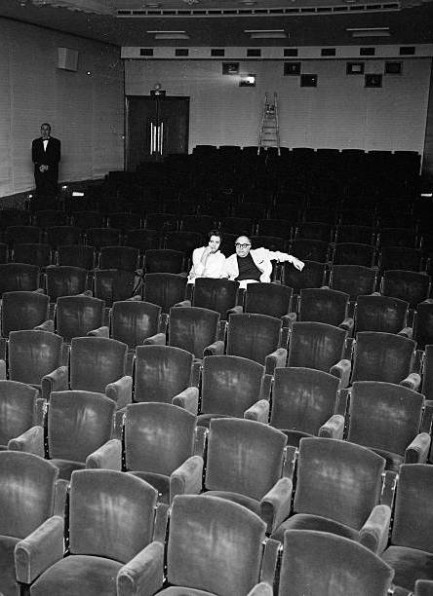 Sophia Loren sits with husband Carlo Ponti, who was a member of the 1966 Festival jury.
Sophia Loren sits with husband Carlo Ponti, who was a member of the 1966 Festival jury.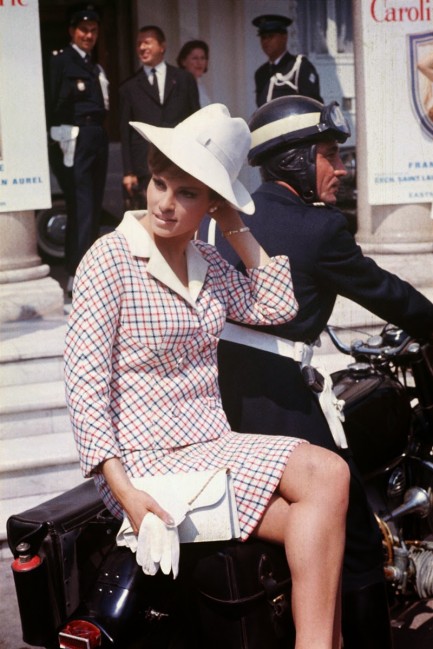 Raquel Welch poses on a motorcycle in 1966.
Raquel Welch poses on a motorcycle in 1966.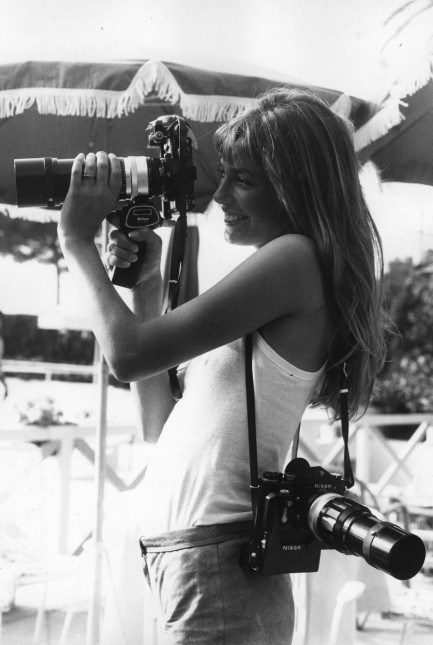 Jane Birkin takes aim with one of her cameras in 1975.
Jane Birkin takes aim with one of her cameras in 1975.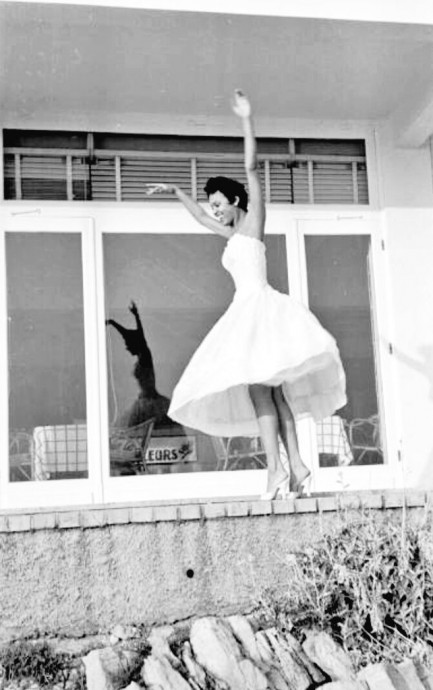 Dorothy Dandridge frolics in 1955, when she was promoting her film Carmen Jones.
Dorothy Dandridge frolics in 1955, when she was promoting her film Carmen Jones.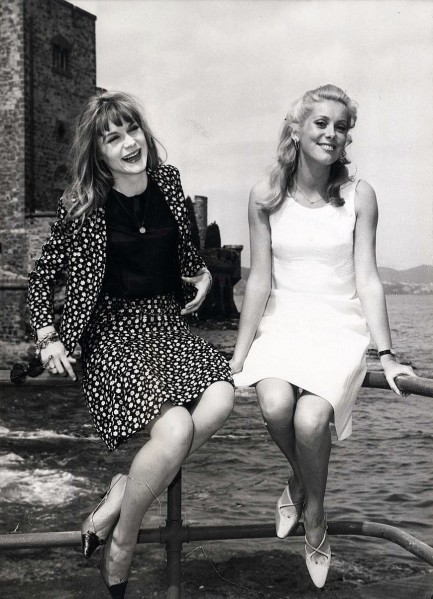 Cinematic icon Catherine Deneuve and her sister Françoise Dorléac in 1965. Dorléac died in an automobile accident a couple of years later.
Cinematic icon Catherine Deneuve and her sister Françoise Dorléac in 1965. Dorléac died in an automobile accident a couple of years later.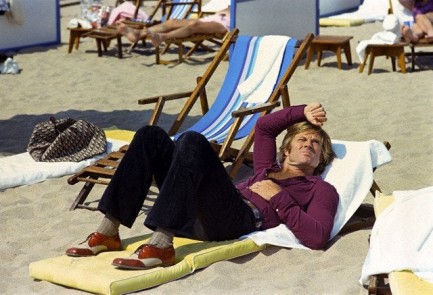 Robert Redford lounges on the beach in 1972. Based on his outfit you'd think he was in Cannes to promote The Sting, but he was actually there for his western Jeremiah Johnson, which screened May 7 of that year.
Robert Redford lounges on the beach in 1972. Based on his outfit you'd think he was in Cannes to promote The Sting, but he was actually there for his western Jeremiah Johnson, which screened May 7 of that year.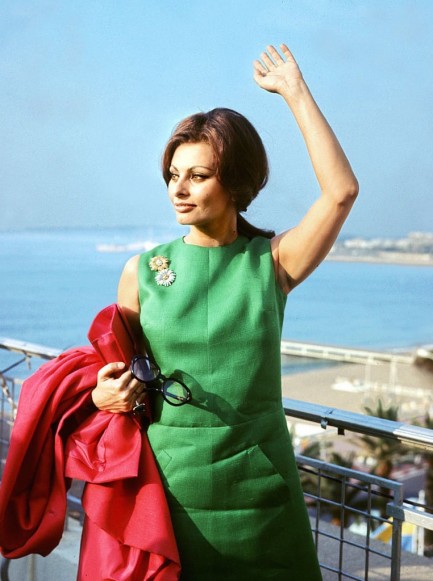 Sophia Loren waves to well-wishers in 1964.
Sophia Loren waves to well-wishers in 1964.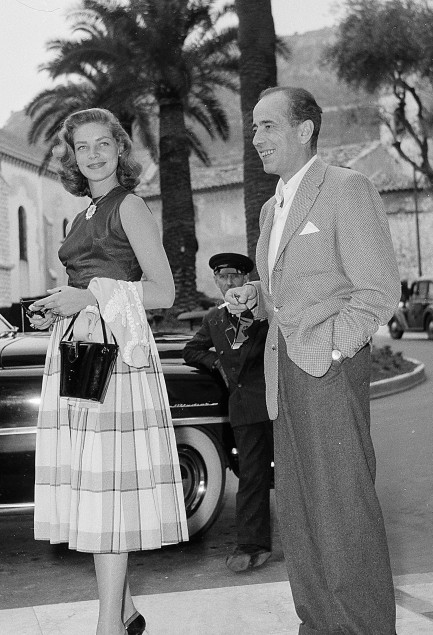 Bogie and Bacall paired up and looking distinguished in 1957.
Bogie and Bacall paired up and looking distinguished in 1957.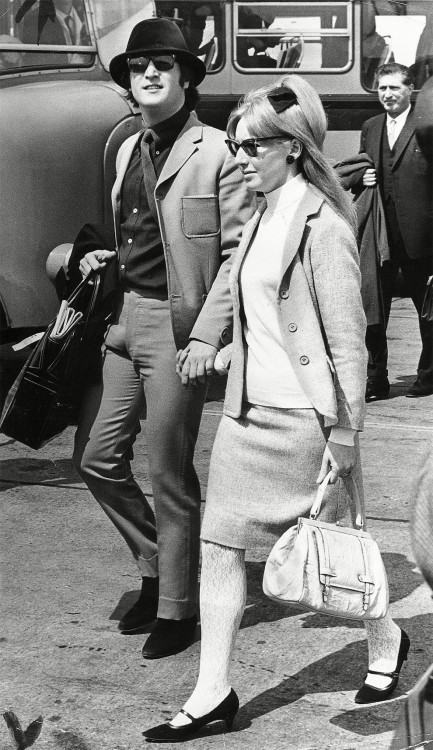
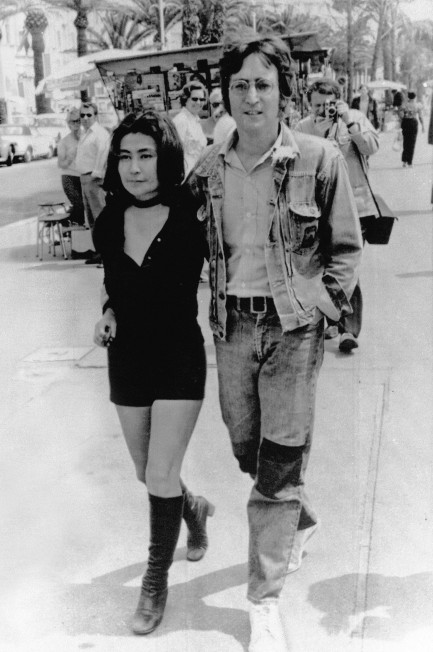 John and Cynthia Lennon in 1965, and John with Yoko Ono in 1971. Every story John told on that second trip probably started with, “When I was here with the first love of my life...” until Yoko smacked him across the mouth.
John and Cynthia Lennon in 1965, and John with Yoko Ono in 1971. Every story John told on that second trip probably started with, “When I was here with the first love of my life...” until Yoko smacked him across the mouth.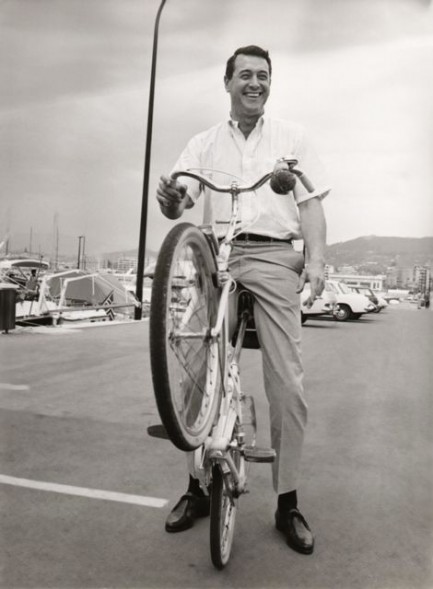 Rock Hudson and bicycle in 1966.
Rock Hudson and bicycle in 1966.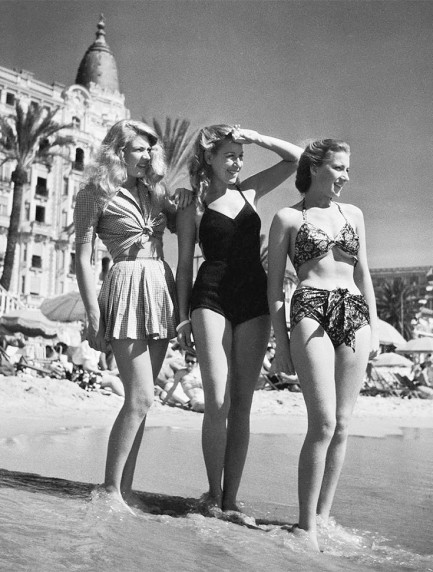 Unidentified actresses pose on the beach in 1947. To the rear is the Hotel Carlton, mentioned in the Edith Piaf image, built on the Croisette and finished in 1910.
Unidentified actresses pose on the beach in 1947. To the rear is the Hotel Carlton, mentioned in the Edith Piaf image, built on the Croisette and finished in 1910.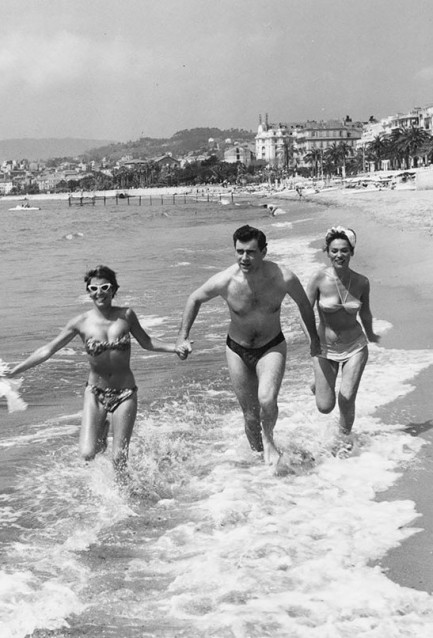 George Baker, Bella Darvi (right—your right, not his), and an unknown acquaintance have a surfside run/photo op in 1956.
George Baker, Bella Darvi (right—your right, not his), and an unknown acquaintance have a surfside run/photo op in 1956.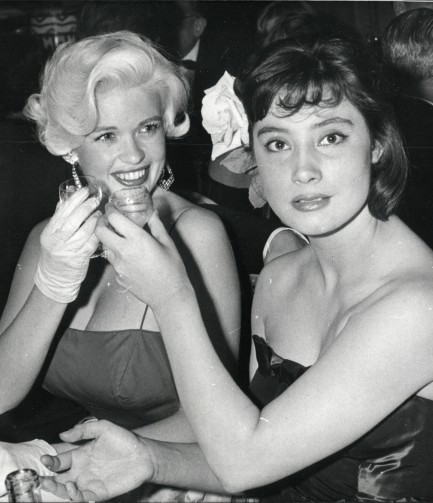 Jayne Mansfield and Russian actress Tatiana Samoïlova enjoy a toast in 1958. Mansfield probably shared the story of how she once made Sophia Loren stare at her boobs, and Samoïlova said, “Cheers to you—well played, you provocative American minx.”
Jayne Mansfield and Russian actress Tatiana Samoïlova enjoy a toast in 1958. Mansfield probably shared the story of how she once made Sophia Loren stare at her boobs, and Samoïlova said, “Cheers to you—well played, you provocative American minx.” French actor Fernandel, whose real name was Fernand Contandin, on his boat Atomic in 1956.
French actor Fernandel, whose real name was Fernand Contandin, on his boat Atomic in 1956.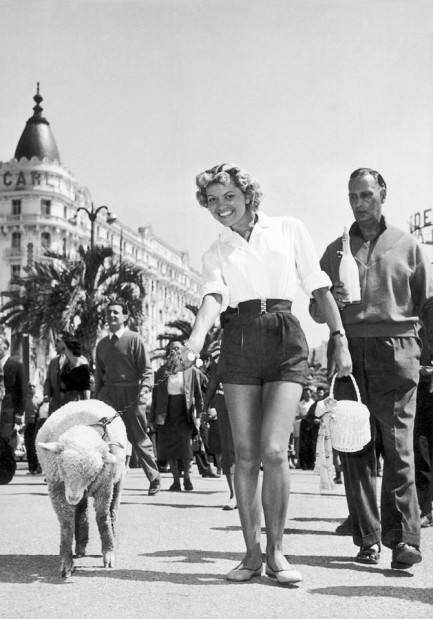 Arlette Patrick figures out a different way to generate publicity—by walking her sheep on the Croisette in 1955.
Arlette Patrick figures out a different way to generate publicity—by walking her sheep on the Croisette in 1955.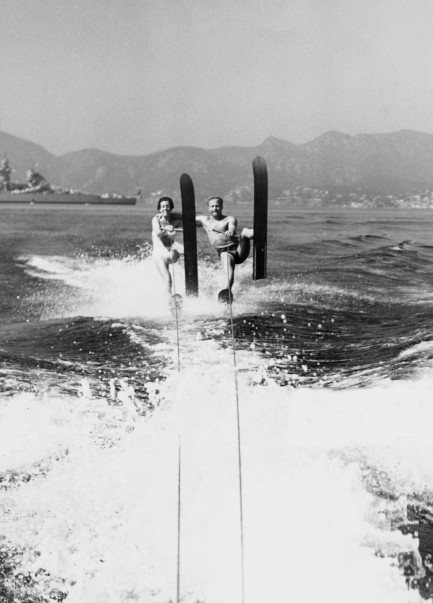 A pair of water skiers show perfect form in 1955, as a battleship floats in the background.
A pair of water skiers show perfect form in 1955, as a battleship floats in the background.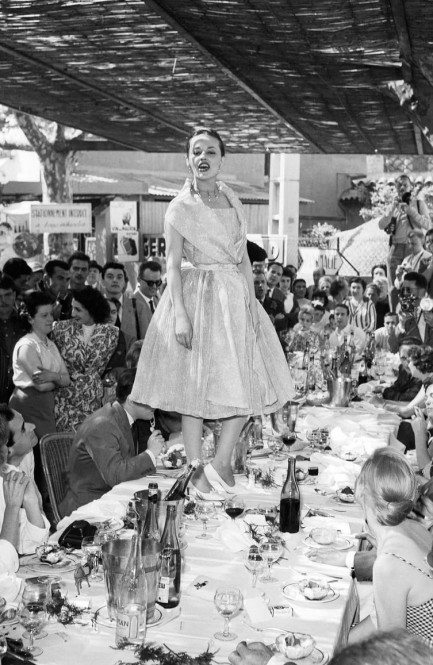 Jeanne Moreau, for reasons that are unclear, poses on a banquet table in 1958. Most sources descibe this in such a way as to make it seem spontaneous, but we have our doubts. It's a great shot, though.
Jeanne Moreau, for reasons that are unclear, poses on a banquet table in 1958. Most sources descibe this in such a way as to make it seem spontaneous, but we have our doubts. It's a great shot, though. Two unidentified women take in the scene from the terrace of the Hotel Carlton, 1958. This shot is usually said to portray two tourists, but the woman on the left is the same person as in the bikini lunch shot from earlier, which tells us she's a model or actress, and both photos are staged. Like we said, publicity is everything in Cannes.
Two unidentified women take in the scene from the terrace of the Hotel Carlton, 1958. This shot is usually said to portray two tourists, but the woman on the left is the same person as in the bikini lunch shot from earlier, which tells us she's a model or actress, and both photos are staged. Like we said, publicity is everything in Cannes.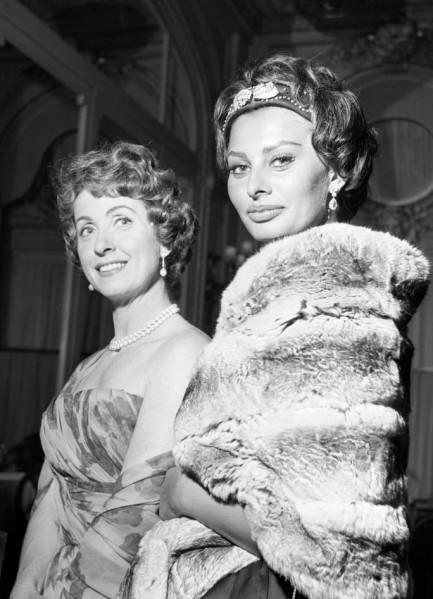
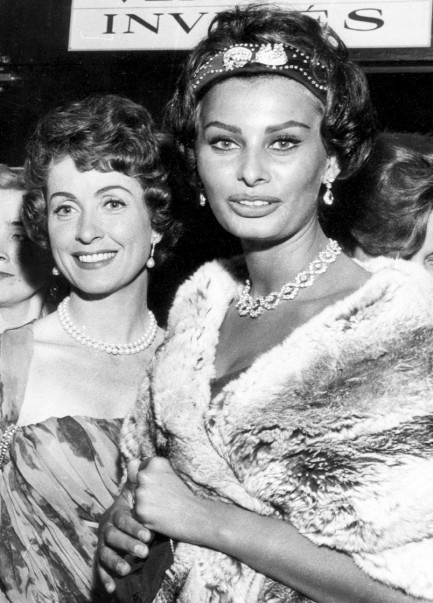 Danielle Darrieux and Sophia Loren at the 11th Cannes Film Festival, 1958.
Danielle Darrieux and Sophia Loren at the 11th Cannes Film Festival, 1958.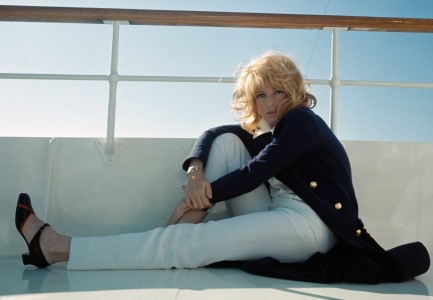 Italian actress Monica Vitti chills on a boat in 1968.
Italian actress Monica Vitti chills on a boat in 1968. Aspiring stars catch some rays on the Croisette beach in 1955. The two large posters behind them are for The Country Girl with Grace Kelly, and Jules Dassin's Du rififi chez les hommes, both below.
Aspiring stars catch some rays on the Croisette beach in 1955. The two large posters behind them are for The Country Girl with Grace Kelly, and Jules Dassin's Du rififi chez les hommes, both below.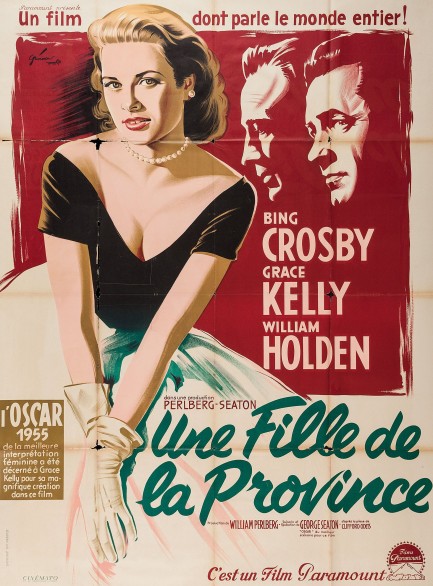
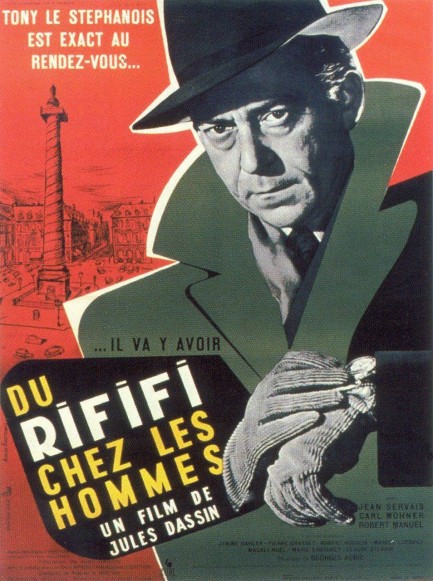
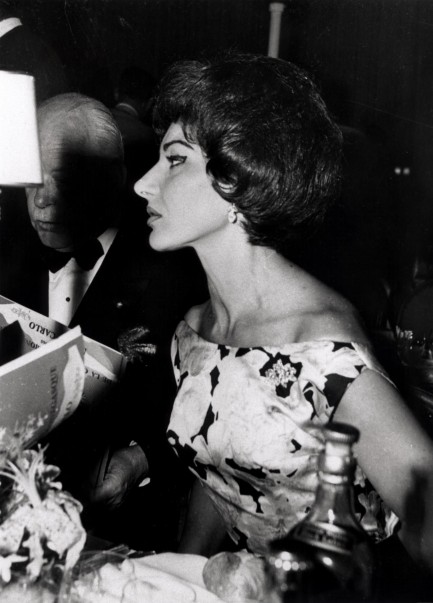 The renowned opera singer Maria Callas, 1960.
The renowned opera singer Maria Callas, 1960.FranceCannesFestival du CannesCannes Film FestivalPalme d’OrLa dolce vitaA Man Called AdamThe BirdsAlfred HitchcockEdith PiafDiana DorsGinger RogersKirk DouglasBrigitte BardotMichèle MorganRobert MitchumSimone SylvaRomy SchneiderAlain DelonSidney PoitierJean SebergNatalie WoodGrace KellySammy Davis Jr.Sharon TateRoman PolanskiMarlene DietrichTippi HedrenGene KellyMaria CallasSophia LorenCarlo PontiRaquel WelchJane BirkinJoan ScottDorothy DandridgeRobert RedfordJohn LennonCynthia LennonYoko OnoRock HudsonLauren BacallHumphrey BogartGeorge BakerBella DarviJayne MansfieldTatiana SamoïlovaCatherine DeneuveFrançoise DorléacFernandelArlette PatrickJeanne MoreauDanielle DarrieuxBernard BlierPhilomène ToulouseMonica Vittiposter artcinema
| Vintage Pulp | May 6 2020 |

So, I'm off to that crucial business meeting with— Wow, that thing's transparent, isn't it? Well, money can wait.
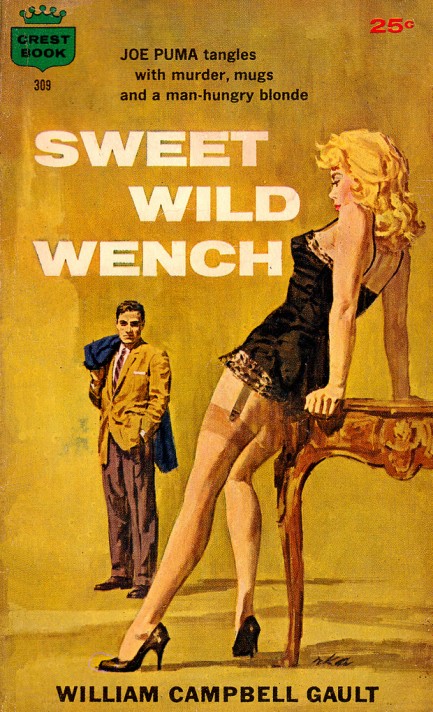
Above, a beautiful Bob Abbett cover for William Campbell Gault's Sweet Wild Wench, published by Crest Books in 1959. Abbett used a still of Brigitte Bardot from the 1958 film En cas de malheur as his inspiration. It certainly worked on us—we wanted to read this entirely because of the cover art. The story deals with a promiscuous private eye named Joe Puma who's hired to look into the activities of a Los Angeles cult, but soon finds himself tangled up in two murders, multiple lovers, and various pulp fiction tropes, which his main character actually refers to in his interior monologues as being like “something out of the pulps.” We appreciated the meta touch, the narrative has a nice L.A. feel, and there's a pretty good fight scene about three quarters of the way through, but the long and winding mystery resolves with a fizzle. Two Gaults down, two meh results. We'll dutifully try another.
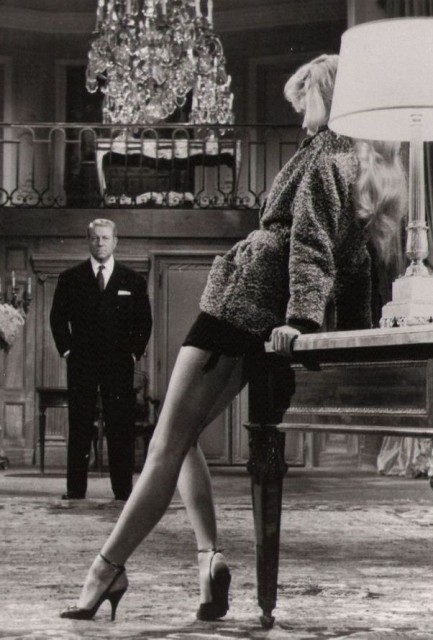
| Vintage Pulp | Apr 11 2020 |

Goodis gets down and dirty while Hooks takes it up a notch.
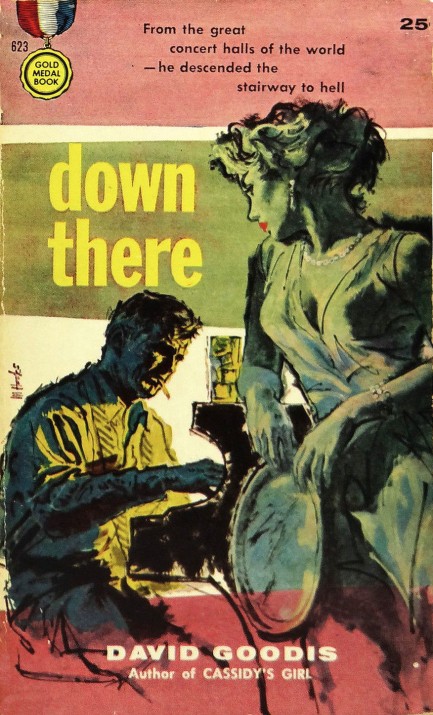
This cover for David Goodis's 1956 novel Down There was painted by Mitchell Hooks, one of the unique talents of the paperback art era. Hooks worked in different modes. Often he utilized the type of line art you'd find in a high quality comic book or graphic novel, such as here and here. Other times he used color blocking for his backgrounds, such as on the above cover and the one you see at this link. He also used a lot of color bleeds, an example of which you see on his brilliant front for Madball, the second one at this link. And he worked in a more realistic mode too, when the mood struck. For Down There he mixed techniques, using a bleed in black to impart a film noir feel, and pairing his two figures with his trademark color-blocking. The effect is magnificent. Hooks was simply a highly versatile artist who always managed to surprise, and that makes his work a constant pleasure to seek out.
His cover for Down There fits Goodis like a glove. The novel is the unrelentingly grim story of a man whose piano playing genius saves him from a life of crime and transforms him into a classical music star, but who is inexorably dragged back into the depths of violence and revenge when his criminal brother needs protection. We soon learn that there are two brothers, both crooks, both neck deep in organized crime trouble. The reader catches no breaks—Goodis is matter-of-factly dark, spinning the tale from the point-of-view of an emotionally crippled main character, and crushing hope in heartwrenching ways that make the turning of pages a real effort at times.
Why put yourself through something like this? Well, it's very stylish, so much so that French director François Truffaut fell in love with it and adapted it to film in the form of Tirez sur le pianiste, known in English as Shoot the Piano Player. Truffaut was world famous after winning best director at the 1959 Cannes Film Festival for Les Quatre Cents Coups, aka The 400 Blows, so choosing Down There for his next project says plenty about the book. Goodis was well received by French directors in general. Other adaptations of his work were made by Pierre Chenal, Jacques Tourneur, Henri Verneuil, Francis Girod, René Clément, Gilles Behat, and Jean-Jacques Beineix. That's just remarkable. We'll probably watch some of those films, and you can be sure we'll revisit both David Goodis and Mitchell Hooks imminently.
| Femmes Fatales | Feb 7 2020 |

There are no small parts. Only small casting agents.
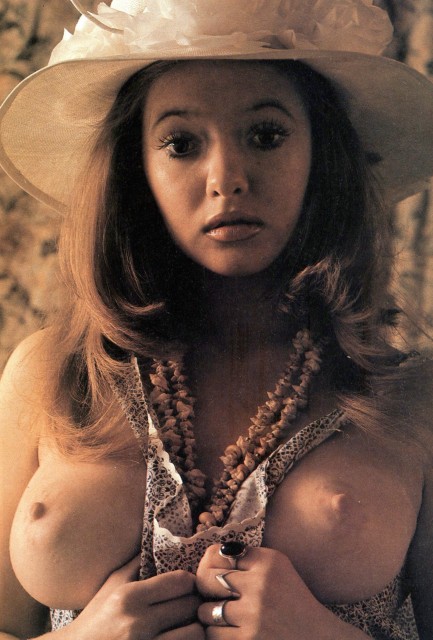
Above is a lovely shot of British actress Zoe Hendry, who we last saw in 1975's erotic epic Butterfly, and whose other credits read like a cautionary tale of cinematic ambition smashed on the rocks of rent paying reality. She's played, in no particular order, “naked college girl,” in 1974's Confessions of a Window Cleaner, “native dancer,” in 1976's Queen Kong, “topless patient,” in 1978's What's Up Nurse!, and, “other girl,” in 1974's The Man Who Couldn't Get Enough. And who can forget 1976's infamous Nastassja Kinski vehicle To the Devil a Daughter, in which Hendry played “first girl”?
Yes, it's quite a résumé Hendry accumulated, but since she originally got her break on The Benny Hill Show—which made an industry of scantily clad women—her stalwart appearances in sexploitation films are no surprise. But she eventually outflanked one-track-minded movie casting agents by shifting back to television during the 1980s, where she got a chance to act more seriously. Probably got paid better too. Still, we're irresistibly drawn to titles like Queen Kong. Maybe we have one-track minds too, but we have to watch that, right? Right. We'll do the heavy lifting so you don't have to, then report back.
Yes, it's quite a résumé Hendry accumulated, but since she originally got her break on The Benny Hill Show—which made an industry of scantily clad women—her stalwart appearances in sexploitation films are no surprise. But she eventually outflanked one-track-minded movie casting agents by shifting back to television during the 1980s, where she got a chance to act more seriously. Probably got paid better too. Still, we're irresistibly drawn to titles like Queen Kong. Maybe we have one-track minds too, but we have to watch that, right? Right. We'll do the heavy lifting so you don't have to, then report back.
| Hollywoodland | Feb 6 2020 |

Master of all he surveys.

We wanted to do a small post on Kirk Douglas, who died yesterday at the astonishing age of 103, but we took time to look around for a unique photo. This shot shows him in one of our favorite cities, Donostia-San Sebastian, standing atop Igeldo (or Igueldo), one of the seaside town's several large hills. He's looking toward the Bahia de la Concha with the Torreón de Monte Igueldo at his back. It's a majestic shot, fitting for such an icon, far better than showing him greased up as Spartacus, in our opinion. It was made in 1958 when he was attending the sixth Zinemaldia, aka the San Sebastián Film Festival, which was showing his film The Vikings. We don't generally do posts on Hollywood deaths. Why? Because there are so many. Anyone who loves vintage film knows that significant performers, writers, and directors are dying regularly, and we don't want Pulp Intl. to become an obituary roll. But for Kirk Douglas, one of film's all time greats, a consummate actor, an indispensable film noir bad guy, all the rules must be broken. See another max cool image here.
| Vintage Pulp | Aug 28 2019 |

Big screen Thief gets the job done but isn't quite the perfect crime.
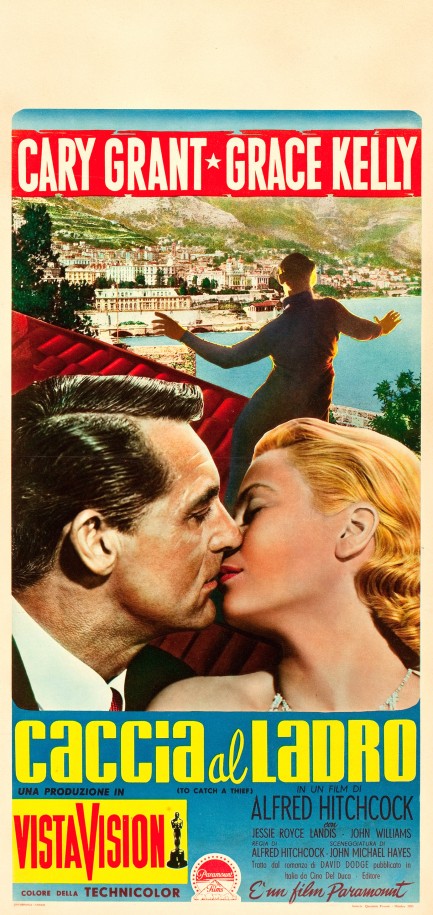
This is a spectacular Italian poster for Caccia al ladro, aka To Catch a Thief, with Cary Grant and Grace Kelly. The moviemakers opted for a photo-illustration rather than a painting, and it befits the star power of the movie. It was based on David Dodge's best seller of the same name, and in truth it's a pretty simple-minded adaptation of the book. You can just hear the studio execs saying: “We know it's in the novel, but we can't have the star in disguise half the movie, we can't have the romance go unacknowledged until the final reel, and we for damn sure can't have the secondary female lead be more beautiful than Grace Kelly.” Movies are a different medium than books, and changes always happen, but it's just interesting to observe what those changes are. The main change is this: Dodge's novel has suspense, while Hitchcock's adaptation does not. That probably wasn't intentional.
To Catch a Thief is a superstar vehicle, and with Grant and Kelly in the lead roles, and Hitchcock in the director's chair, it's pretty clear the studio considered the hard work done. Extensive French Riviera location shooting and VistaVision widescreen film processing are nice bonuses, but the honchos should have had screenwriter John Michael Hayes hammer the script out a little smoother. We're not being iconoclasts here. The movie received mixed reviews upon release, with some important critics calling it a failure. That's going too far—it isn't a failure. We don't think Grant, Kelly, and Hitchcock would have been capable of making anything but a good movie at this stage. But considering the source material it could have been a perfect movie. To Catch a Thief premiered in the U.S in early August 1955, and in Italy at the Venice Film Festival today the same year.
To Catch a Thief is a superstar vehicle, and with Grant and Kelly in the lead roles, and Hitchcock in the director's chair, it's pretty clear the studio considered the hard work done. Extensive French Riviera location shooting and VistaVision widescreen film processing are nice bonuses, but the honchos should have had screenwriter John Michael Hayes hammer the script out a little smoother. We're not being iconoclasts here. The movie received mixed reviews upon release, with some important critics calling it a failure. That's going too far—it isn't a failure. We don't think Grant, Kelly, and Hitchcock would have been capable of making anything but a good movie at this stage. But considering the source material it could have been a perfect movie. To Catch a Thief premiered in the U.S in early August 1955, and in Italy at the Venice Film Festival today the same year.
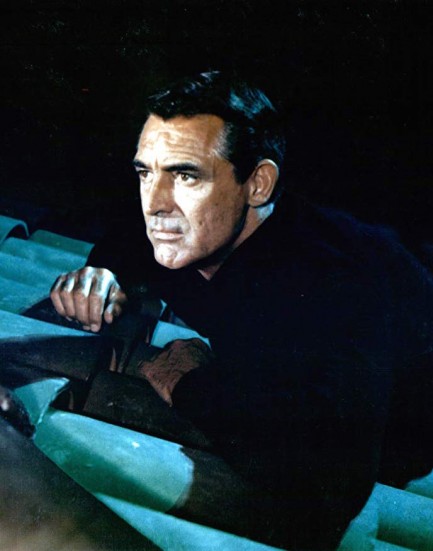
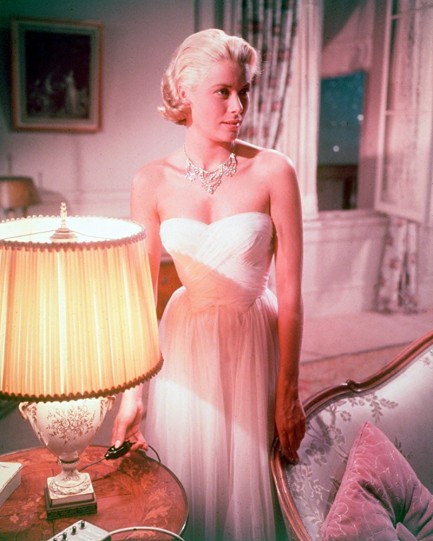
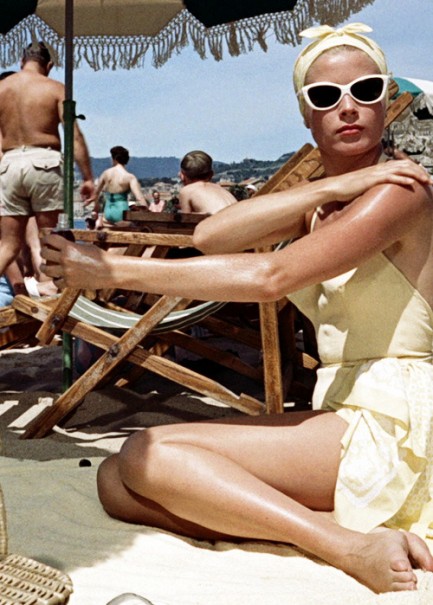
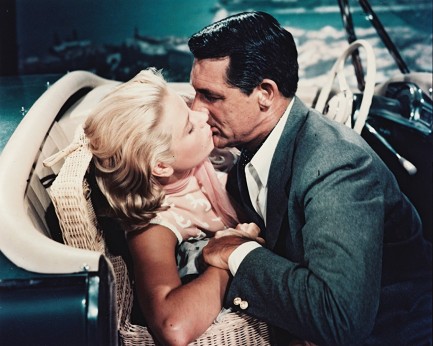
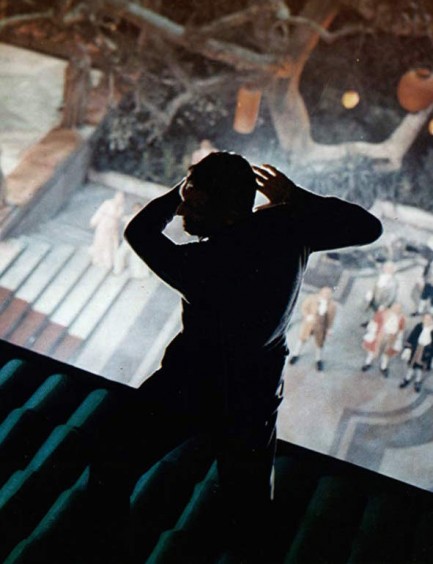
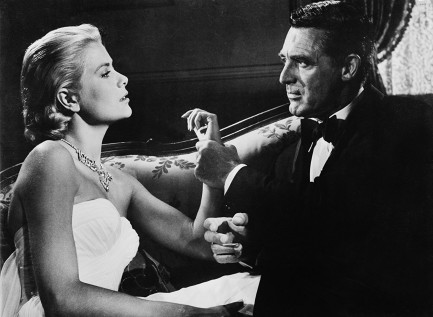
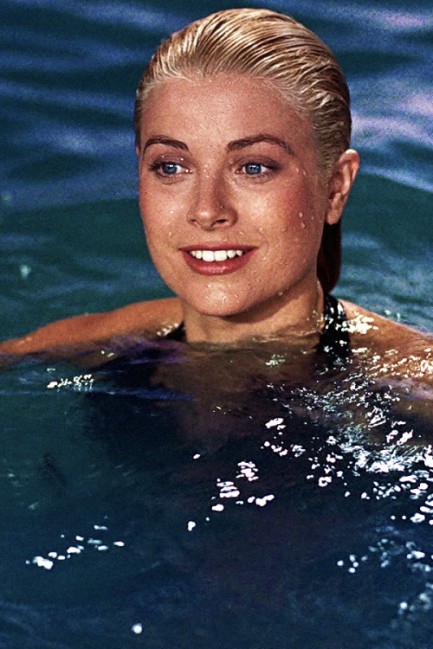
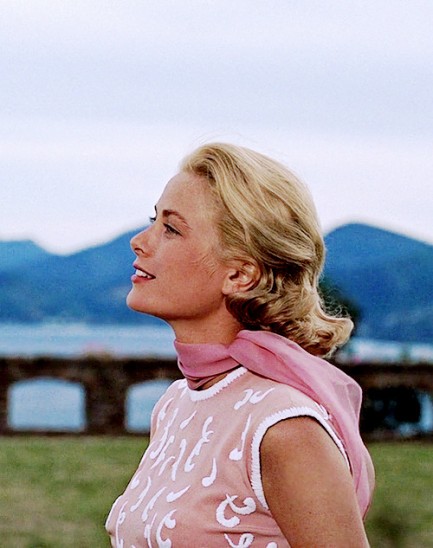
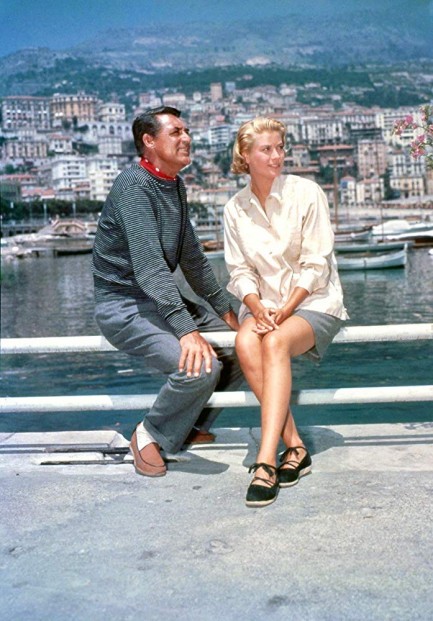
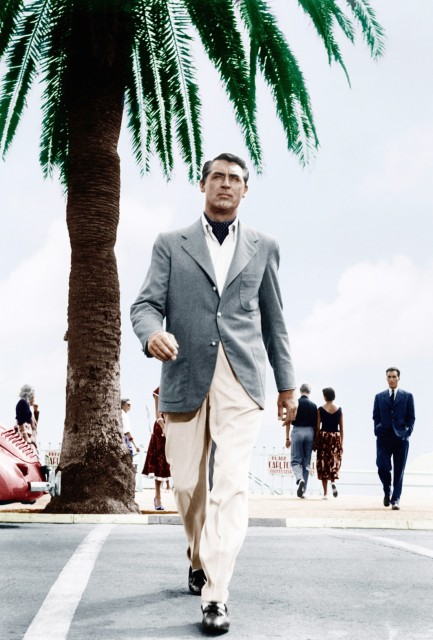
| Vintage Pulp | Jun 27 2019 |

Crazy for feeling so lonely.
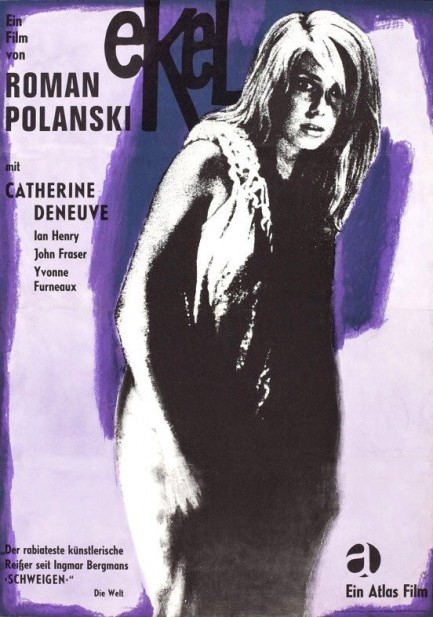
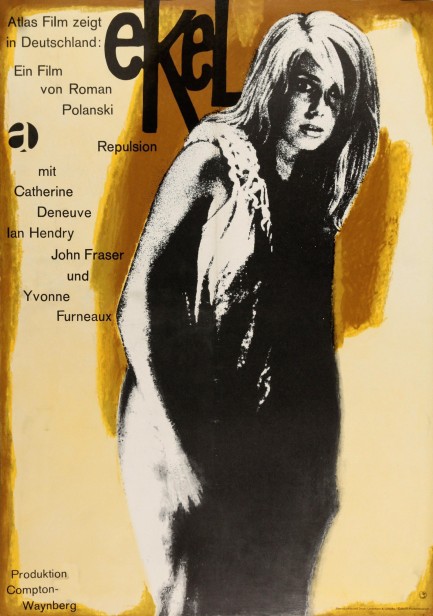
Above, two really nice West German promos for Roman Polanski's quasi-horror flick Ekel, better known as Répulsion, with Catherine Deneuve as a woman who goes crazy in the isolation of her apartment. We talked about this one briefly and shared two Japanese posters for it a while ago. After opening in France and the UK, the film received its debut for German viewers at the Berlin International Film Festival today in 1965.
| Vintage Pulp | May 20 2019 |

I didn't know that a girl like you could make me feel so sad...

A couple of weeks ago we shared a Mexican movie poster we weren't 100% sure was actually from Mexico. This time we're sure—this beautiful promo Antonio Caballero painted for the melodrama La red says right in the lower left corner “impreso en México.” In that previous write-up we also talked about how popular locally produced films were in Mexico before the industry was suffocated by U.S. business and political interests, and this effort is an example. It was made by Reforma Films S.A., based in Mexico City, and starred Libyan born Italian actress Rossana Podesta, Costa Rican actor Crox Alvarado, and U.S. born actor Armando Silvestre. Enticing a burgeoning international star like Podesta over from Europe indicates how established the Mexican film industry was in 1953, when La red was made.
Interestingly, when the movie played in the U.S. it was titled simply Rosanna, which makes sense, because it would be nothing without Podesta. It struck us that even though Toto didn't write their song of obsession “Rosanna” about Podesta, they might as well have. The film begins when a group of men botch a robbery, a shootout commences, and one of the bandits, Antonio, played by Alvarado, tries to help his wounded comrade. But the dying man gasps to Antonio, “Save yourself—for Rossana.” So we know she's a special woman even before seeing her. Antonio does save himself and goes to live on the seaside with Podesta, where the two harvest sea sponges. It's idyllic, but as a wanted thief he has to lay low, which means sending her alone to town to sell their catch. And the men in the town are... well... see below:
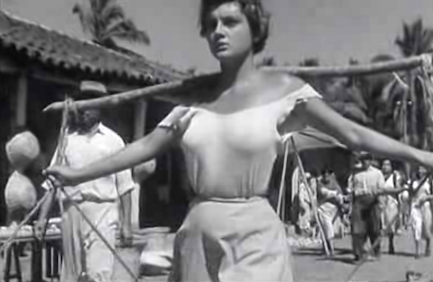
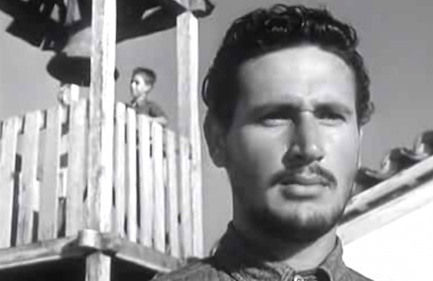 I am intrigued by this spicy redhead.
I am intrigued by this spicy redhead.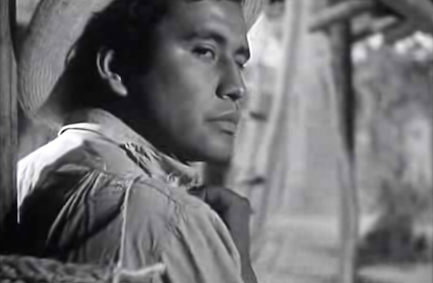 I too find myself somewhat taken with this mysterious chile pepper of a woman.
I too find myself somewhat taken with this mysterious chile pepper of a woman.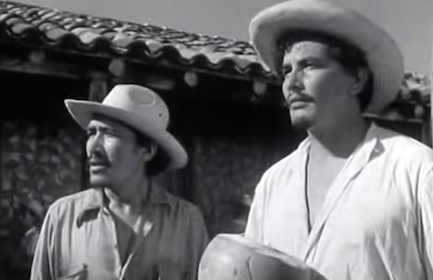 Perhaps I'll invite her to coffee and a cronut. That's a cross between a croissant and a donut, my friend, and living out there on the idyllic seashore as she does, I bet she's never had one.
Perhaps I'll invite her to coffee and a cronut. That's a cross between a croissant and a donut, my friend, and living out there on the idyllic seashore as she does, I bet she's never had one.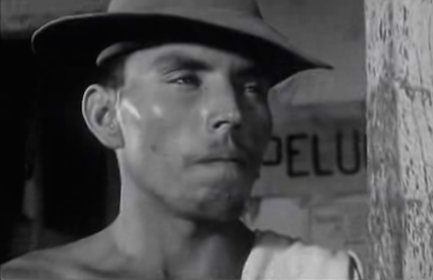 I wonder if she's a fan of our great romantic poet Salvador Díaz Mirón?
I wonder if she's a fan of our great romantic poet Salvador Díaz Mirón?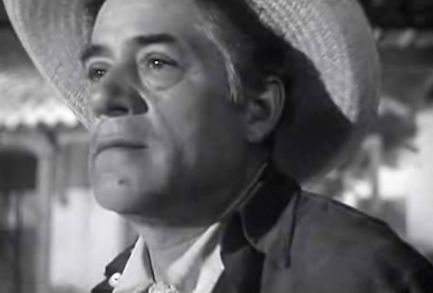 I'm certain she has no idea how quickly European skin can burn in this tropical climate.
I'm certain she has no idea how quickly European skin can burn in this tropical climate.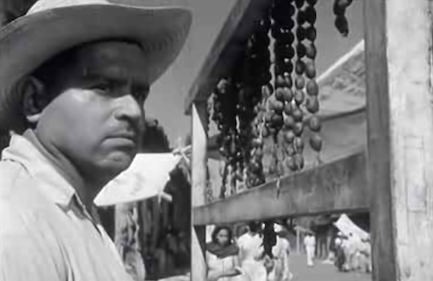 I'm admittedly less high minded than other men, and mainly wonder what she looks like naked, and whether the carpet is red too.
I'm admittedly less high minded than other men, and mainly wonder what she looks like naked, and whether the carpet is red too.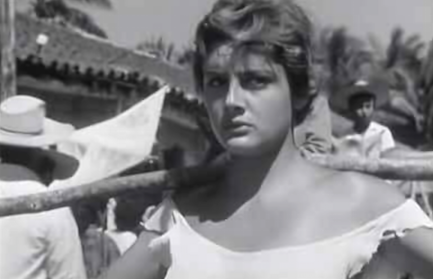 What the hell are all these guys staring— Oh. I think it's me.
What the hell are all these guys staring— Oh. I think it's me. Clearly, these trips into town are menacing affairs for Podesta. If you were to screen the sequences at an anti-sexual harassment seminar, every guy in the joint would bow his head in shame. Important to note, though, that within the narrative these aggressively pervy guys are depicted in a negative light, with even the soundtrack music growing ominous. When one of Antonio's robbery compatriots shows up in town, he gets into a shootout that leaves two men dead, and therein are sown the seeds of future troubles. We won't say more, save that the film is stagy, stylized, operatic, almost devoid of dialogue, and largely remembered because of Podesta's role. It all worked well enough to earn the Prix International du film le mieux raconté par l'image, aka the Award for Visual Narration, at the Cannes Film Festival.
Moving on to the poster, have a look at a previous Mexican promo we shared last year. It's here. We'll wait. Back? You'd think it was the same person who painted both, but the reason we wanted you to glance at the other one is because it exemplifies the strange phenomenon of artists within the same film industry biting each other's styles. It happened in Italy and Sweden too. Either through direct influence from the studios, or through osmosis due to mutual association, several Mexican artists delved into this art deco tinged style. Check out Leopoldo Mendoza Andrade here. Interesting, right? You'll see what we mean even more clearly when we share posters from other Mexican artists, for example Juan Antonio Vargas. That'll be soon. La Red premiered in Mexico today in 1953.
Moving on to the poster, have a look at a previous Mexican promo we shared last year. It's here. We'll wait. Back? You'd think it was the same person who painted both, but the reason we wanted you to glance at the other one is because it exemplifies the strange phenomenon of artists within the same film industry biting each other's styles. It happened in Italy and Sweden too. Either through direct influence from the studios, or through osmosis due to mutual association, several Mexican artists delved into this art deco tinged style. Check out Leopoldo Mendoza Andrade here. Interesting, right? You'll see what we mean even more clearly when we share posters from other Mexican artists, for example Juan Antonio Vargas. That'll be soon. La Red premiered in Mexico today in 1953.
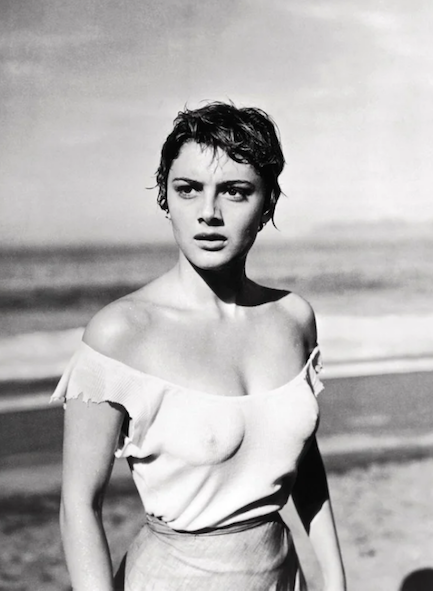
 |
 |




































































